8 April 2011. I got a fairly early start out of Silver City this morning: 7:30 am. I lingered long enough to get some breakfast at the hotel (opened at 7) and let the air warm a bit (from the low-40s). Initially, my left knee was pretty sore, but after pedaling a little while it felt much better.
My route took me east on Route 180 to Central, then on Route 152 through Hanover and up over Emory Pass to Kingston, New Mexico. Central used to be called Santa Clara, but the town became an open-pit copper mine, and residents were relocated. Indeed, the massive Santa Rita Copper Mine, easily viewable from 152, was my first stop this morning.
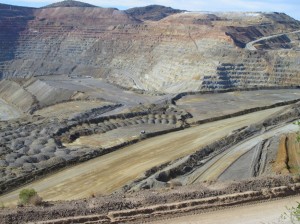
Along with pioneering open-pit mining here, they also developed the process of using sulfuric acid to dissolve copper and then extract the copper from the solution.
The Santa Rita Mine, also known as the Chino Mine, hold the (perhaps dubious) distinction of being the world’s first large-scale open-pit mine. It was here, back in the early 1900s, that such techniques as open-pit mining and solution-extraction of copper from low-grade ore were perfected.
The climb up to Emory Pass has been looming ahead of me for the entire trip so far. It’s the highest elevation of Adventure Cycling’s Southern Tier Route (by a significant margin), but it wasn’t so bad, really. The ascent is fairly gradual, rising about 2,500 feet in 18 miles from the Mimbres River. I had a modest tailwind for most of that, which helped a great deal (near the top it turned into more of a tail-gale).

Traffic was very light on Route 152, so I was able to bike most of the time on the smoother traveled lane.

I biked a little further up from Emory Pass—on a side road—to get to this lookout. The wind was really strong!

An understatement! The curving descent, with 30- or 40-mph gusts whipping me from all sides, as a bit harrowing. I used my brakes a lot in the 8-mile drop of 2,000 feet to Kingston.
I got to Kingston, where I’m staying at the Black Range Lodge, by about 2:30—not bad! Total miles: 51.
When I was looking at the route and discussing it with Ellen Martyn in Brattleboro (who has biked the Southern Tier Route), Kingston rang a bell in my head. I was pretty sure Mark Piepkorn (who used to work for BuildingGreen) had talked about it. Indeed, Mark lived here for a time and edited The Last Straw newsletter from here!
Mark introduced me by e-mail to Catherine Wanek, the owner of the lodge. I have seen her books on strawbale building, which include her gorgeous photographs. Her books include The New Strawbale House (2003), The Art of Natural Building (with coauthors, 2002), and The Hybrid House: Designing with Sun, Wind, Water, and Earth (2010). She was also the editor and publisher of The Last Straw. It’s great to finally meet her!
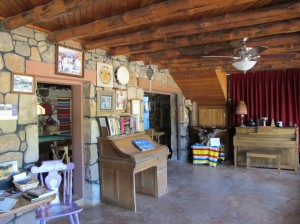
A downstairs sitting area in the Black Range Lodge—with something fascinating to examine at every turn!
The lodge, and the property next door, owned by Tom and Satomi Lander, are well known for earth building workshops and demonstration—through the name LanderLand. I’m tempted to stick around tomorrow morning to tour some of Tom’s projects (he starts a workshop tomorrow morning). But I’m also watching the weather.
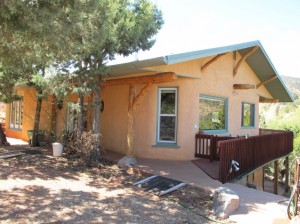
A recently built strawbale guest cottage and Catherine also makes available; lodging rates are quite reasonable.
I’m hoping to get to Las Cruces tomorrow, and the forecast is for strong winds in the afternoon for the area between here and Las Cruces: afternoon winds from 37 to 40 mph with gusts as high as 55 or 60 mph and blowing dust after noon. Unfortunately, the wind is supposed to be coming from the southwest. For the first 26 miles I’ll be heading generally east, then turning pretty directly south in Caballo—could be a tough day!
It’s 89 miles to my destination in Las Cruces, but most of that is fairly flat and some downhill. If I get off by 6 am, I might be able to avoid some of that wind!




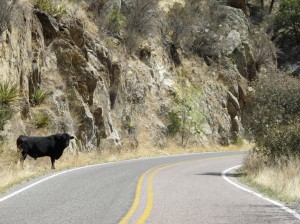
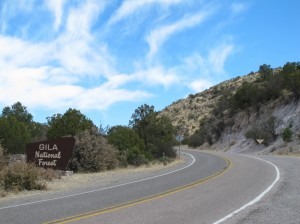

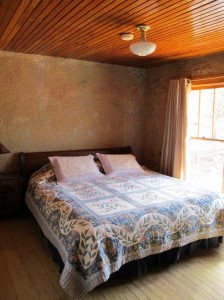

Thanks Alex for the daily news on your blog – we’re following your route on the NM road map. I’m glad to see photos of City of Rocks, which I’ve read about in climbing mags for years. It’s impressive to see your persistence on the road, and read your wry observations. My Mom always said “persistence is a virtue”!
Thanks Malcolm. I’m not feeling very persistent this evening–as you’ll find in reading my next blog.